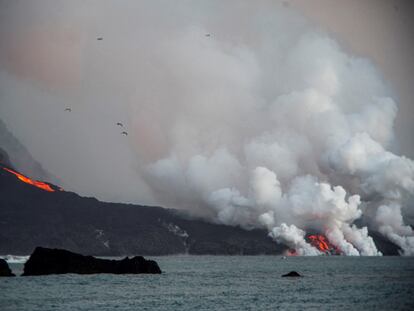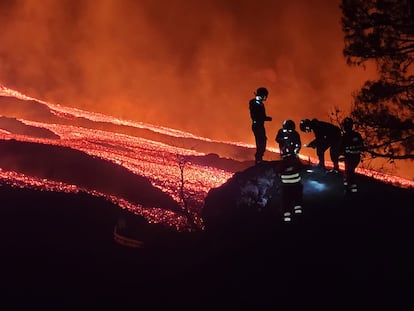La Palma on alert after volcanic cone partially collapses
The breakdown has led to a “notable rise” in lava flow, mobilized loose blocks of molten rock and destroyed more buildings on the Spanish island

The new volcano that began erupting on September 19 on La Palma, in Spain’s Canary Islands, showed its destructive power once again over the weekend. On Saturday, parts of the northern face of the volcano’s cone collapsed, leading the lava to overflow in different directions. This collapse has led to a “notable rise” in the amount of lava flowing out of the volcano, and mobilized loose blocks of molten rock tens of cubic meters in size, said sources at the Canary Islands’ Volcano Risk Prevention Plan (Pevolca) on Sunday.
The breakdown of the northern face of the cone created three new lava flows, Pevolca technical director Miguel Ángel Morcuende said on Saturday. The most worrying of the three has advanced towards the industrial area of El Callejón de la Gata in the town of Los Llanos de Aridane. The Volcanology Institute of the Canary Islands (Involcan) reported on Sunday that the lava destroyed the few remaining buildings still standing north of the town’s Todoque neighborhood, which was nearly completely swallowed up by the lava flow between September 30 and October 1.
The collapse of the northern face of the volcano led to a tense 24 hours, not only because lava from the crater was flowing in different directions; but also because the volcano became more explosive. “Last night [Saturday] was a hard night,” Morcuende admitted on Sunday.
The collapse of part of the volcanic cone did not come as a surprise to Pevolca. According to the emergency committee, “these reconfiguration processes” are perfectly normal with Strombolian eruptions like the one on La Palma, which are characterized by large explosions and a slow lava flow. As such, it is likely that the cone will see further collapses.
Morcuende explained on Sunday that the new lava flows have broken into two branches, both north of the main flow of molten rock. One is currently traveling further north and reached Callejón de la Gata on Sunday. It is moving at a slow speed of around five meters per hour. Authorities are closely watching its advance to see whether action needs to be taken to protect the local population.
The second branch has crossed the LP-213 road and is traveling north to south between Todoque and Puerto Naos in the town of Tazacorte. This branch is expected to advance parallel to the main flow and make its way to the sea by going north of Todoque mountain. It is important to note that when the main flow reached the Atlantic Ocean at the end of September it went around the south side of the mountain.
According to Morcuende, the lava has so far affected 525.27 hectares, an area that grew by 33 hectares in just 24 hours. At its widest point, the river of molten rock stretches 1,520 meters, up from 1,250 meters. This includes 132 hectares for agriculture, which is one of the island’s main economic drivers. According to the latest data from the European observation system Copernicus, the lava has completely or partially destroyed 1,186 buildings, with 95 more at risk.
Meanwhile, seismic activity has increased on La Palma, which is part of the Canary Islands, a volcanic archipelago off the coast of northwestern Africa. On Sunday, 21 tremors were recorded on the island, the largest of which measured 3.8 on the Richter scale and took place at a depth of 34 kilometers. Of the 21 registered tremors, 18 took place in the municipality of Fuencaliente, two in El Paso and one in Mazo. Pevolca’s scientific director María José Blanco warned on Sunday that these earthquakes could lead the volcanic cone to collapse further.
Air quality, however, remained unaffected on Sunday by the increased activity, meaning the two airports on the nearby island of Tenerife were able to remain open. But the wind direction and disposition of the plume of smoke coming from the volcano are expected to change from Monday. “We can’t rule out that this will affect the operations of the airports in Tenerife,” said Blanco.
Spanish Defense Minister Margarita Robles visited La Palma on Sunday to see the affected areas and meet with members of the Military Emergency Unit who have been deployed to address the crisis. Robles also announced that the armed forces will help with the effort to clear away ash from the volcano starting Monday.
Tu suscripción se está usando en otro dispositivo
¿Quieres añadir otro usuario a tu suscripción?
Si continúas leyendo en este dispositivo, no se podrá leer en el otro.
FlechaTu suscripción se está usando en otro dispositivo y solo puedes acceder a EL PAÍS desde un dispositivo a la vez.
Si quieres compartir tu cuenta, cambia tu suscripción a la modalidad Premium, así podrás añadir otro usuario. Cada uno accederá con su propia cuenta de email, lo que os permitirá personalizar vuestra experiencia en EL PAÍS.
¿Tienes una suscripción de empresa? Accede aquí para contratar más cuentas.
En el caso de no saber quién está usando tu cuenta, te recomendamos cambiar tu contraseña aquí.
Si decides continuar compartiendo tu cuenta, este mensaje se mostrará en tu dispositivo y en el de la otra persona que está usando tu cuenta de forma indefinida, afectando a tu experiencia de lectura. Puedes consultar aquí los términos y condiciones de la suscripción digital.
More information

La Palma struck by new quake and more destruction from erupting volcano
Últimas noticias
Most viewed
- Reinhard Genzel, Nobel laureate in physics: ‘One-minute videos will never give you the truth’
- Oona Chaplin: ‘I told James Cameron that I was living in a treehouse and starting a permaculture project with a friend’
- Pablo Escobar’s hippos: A serious environmental problem, 40 years on
- Charles Dubouloz, mountaineering star, retires at 36 with a farewell tour inspired by Walter Bonatti
- Why we lost the habit of sleeping in two segments and how that changed our sense of time










































